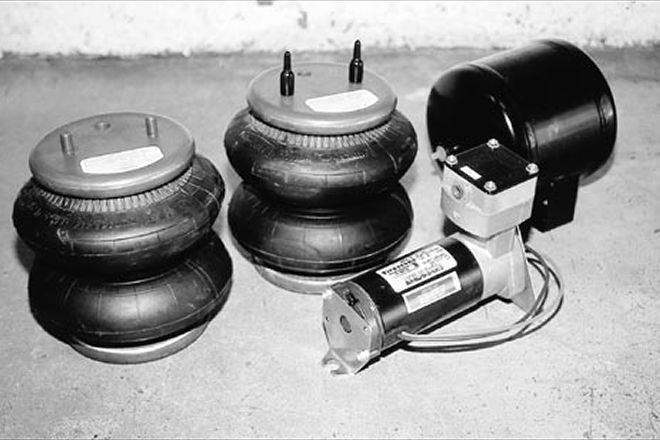
 David Kennedy
Contributor
David Kennedy
Contributor
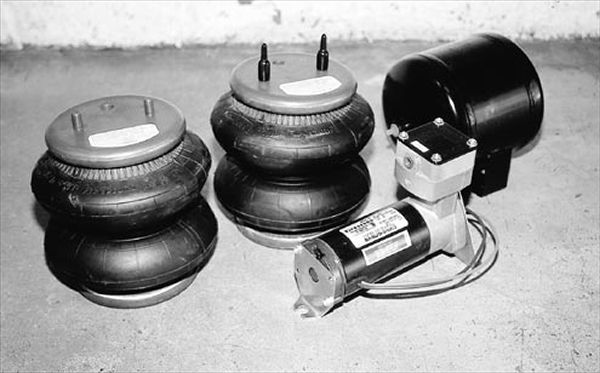 To support the weight of any towable toys we could find, Off Road Unlimited specified two of these Ride-Rite convoluted air springs (PN 224C), an air compressor (PN 2047), and an in-cab-mounted control panel (PN 2149) from Firestone. This air spring system will permit worry-free towing and hauling even with the spongy-soft leaf springs that ORU typically runs for better off-road performance.
To support the weight of any towable toys we could find, Off Road Unlimited specified two of these Ride-Rite convoluted air springs (PN 224C), an air compressor (PN 2047), and an in-cab-mounted control panel (PN 2149) from Firestone. This air spring system will permit worry-free towing and hauling even with the spongy-soft leaf springs that ORU typically runs for better off-road performance.
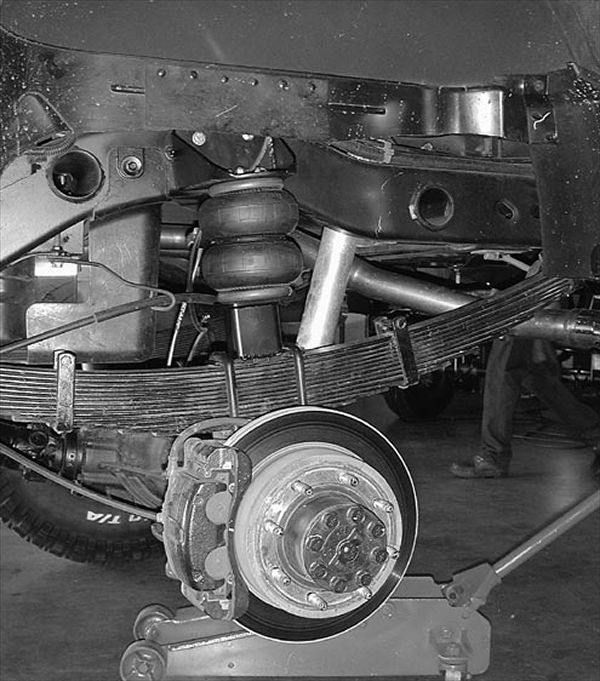 Ride-Rite air springs are available for over a hundred different applications. Surprisingly enough, there is no direct bolt-on kit for ’01 Suburbans with an 8-inch lift. But that didn’t stop ORU from fabricating these extended upper and lower mounts to get up to 5,000 pounds of extra load control that could be necessary when towing. For ORU the sky is the limit when it comes to fabrication. If you’re going to do the same, make the brackets strong and design them so that they locate the bags vertically, with the mounting surfaces parallel to each other. Warning: Just because the airbags can support up to 5,000 pounds doesn’t mean you can overload your truck. Pay close attention to the rear axle’s gross axle weight rating, as well as the truck’s GVW.
Ride-Rite air springs are available for over a hundred different applications. Surprisingly enough, there is no direct bolt-on kit for ’01 Suburbans with an 8-inch lift. But that didn’t stop ORU from fabricating these extended upper and lower mounts to get up to 5,000 pounds of extra load control that could be necessary when towing. For ORU the sky is the limit when it comes to fabrication. If you’re going to do the same, make the brackets strong and design them so that they locate the bags vertically, with the mounting surfaces parallel to each other. Warning: Just because the airbags can support up to 5,000 pounds doesn’t mean you can overload your truck. Pay close attention to the rear axle’s gross axle weight rating, as well as the truck’s GVW.
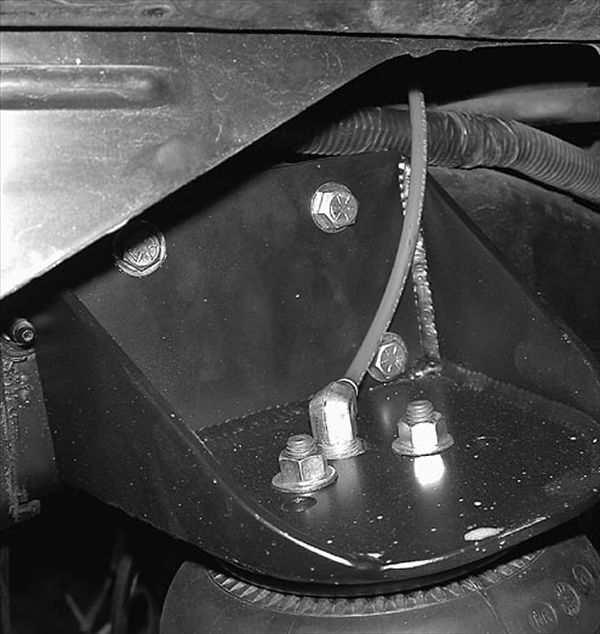 Here the Ride-Rite air springs have been installed in a custom upper mount. Firestone supplies “push-to-connect fittings” to make plumbing the air lines a much easier job. Plan how you will route the lines and run them from the pump to the air springs before you make any cuts. Make sure to route lines away from hot exhaust parts and any place they could get chafed or pinched. When you do cut the air lines to make the connections, use a sharp knife and not a pair of diagonal cutters. If you crush the ends of the air lines they will leak around the connector.
Here the Ride-Rite air springs have been installed in a custom upper mount. Firestone supplies “push-to-connect fittings” to make plumbing the air lines a much easier job. Plan how you will route the lines and run them from the pump to the air springs before you make any cuts. Make sure to route lines away from hot exhaust parts and any place they could get chafed or pinched. When you do cut the air lines to make the connections, use a sharp knife and not a pair of diagonal cutters. If you crush the ends of the air lines they will leak around the connector.
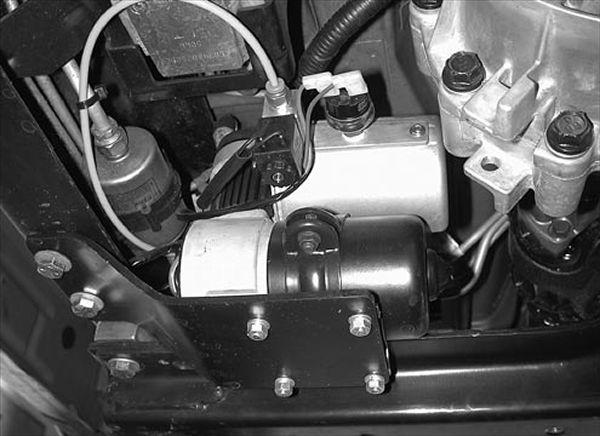 You can mount the electric air compressor anywhere it will be protected and has space to fit. We don’t know about you, but we hate hearing electric pumps cycle on and off on our tow rigs. We’ve found that one of the best places to mount the compressor is on a framerail. This way the truck’s body mounts will isolate the driver and passengers from the noise and vibration these babies make. Here you can see how the pump is mounted up high and protected by the transmission crossmember and its own small skidplate.
You can mount the electric air compressor anywhere it will be protected and has space to fit. We don’t know about you, but we hate hearing electric pumps cycle on and off on our tow rigs. We’ve found that one of the best places to mount the compressor is on a framerail. This way the truck’s body mounts will isolate the driver and passengers from the noise and vibration these babies make. Here you can see how the pump is mounted up high and protected by the transmission crossmember and its own small skidplate.
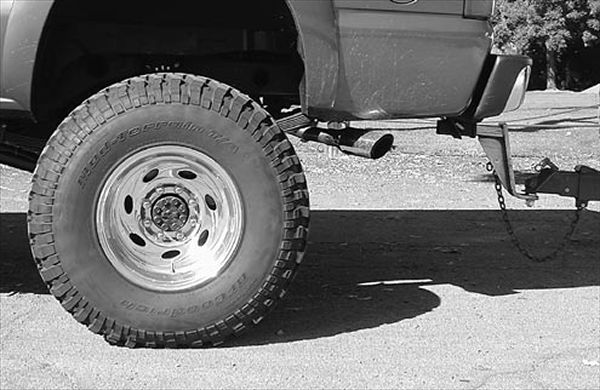 How do you know how much air pressure to use? Firestone recommends that you “add enough air pressure to level the vehicle, and adjust the air pressure from that point up or down in 5 psi increments” for comfort and stability. When ORU’s 3/4-ton Suburban is empty they run the bags at 5 psi. In this photo the Ride-Rite springs are at about 75 psi to support the tongue weight of the go-fast boat.
How do you know how much air pressure to use? Firestone recommends that you “add enough air pressure to level the vehicle, and adjust the air pressure from that point up or down in 5 psi increments” for comfort and stability. When ORU’s 3/4-ton Suburban is empty they run the bags at 5 psi. In this photo the Ride-Rite springs are at about 75 psi to support the tongue weight of the go-fast boat.
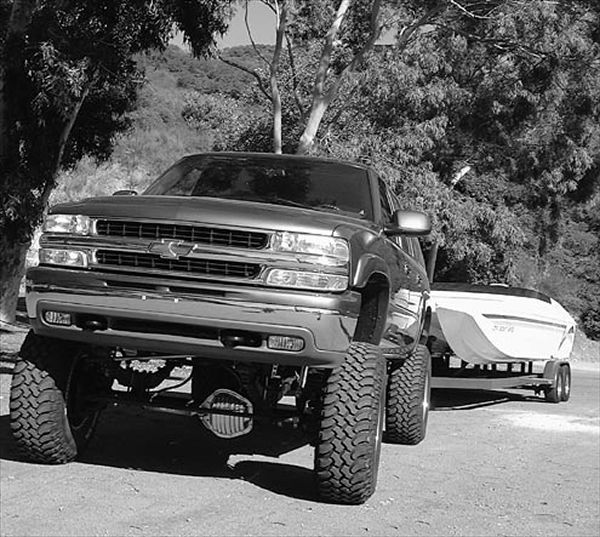
Tractor trailer and heavy-duty truck designers have been using airbag helper springs forever. They are the perfect suspension solution if you want a truck to give a soft and flexible ride but still be able to tow a load. Our ¾-ton test Suburban runs a super-soft 6-inch lift that was good for a 774 RTI score, but would drag its tail when we hooked up a trailer. A set of air helper springs from Firestone seemed like the perfect solution for our multipurpose truck. The beauty of airbag helper springs is that they are adjustable to support the load of the truck whether you’re hauling a bag of Huggies home from the grocery store or a trailer full of engine blocks to the swap meet. That way the ride is never too harsh or too soft for the load or road condition.
To find out if air springs were right for us we stole a big-block Chevy-powered speedboat (hey, we haven’t figured out how to wheel across the lake yet!) to use as tongue weight and to give you an idea of how bad the rear of the truck sagged when we hooked up a trailer. We scientifically calculated the tongue weight of our test trailer at “freakin’ heavy!” and with it weighing down the rear of the Sub, we blinded a few oncoming drivers with our low beams that now shot up into the air like searchlights.
Back to the Off Road Unlimited shop we went to have a set of Firestone Ride-Rite air springs installed to supplement the load carrying capacity of our rear leaf packs. After we ran 12 volts to the compressor and checked for leaks, we aired up the springs to 75 psi and drove back out to the lake (don’t tell the boss!) to feel the results. The first thing we noticed was how much better the steering felt. Without the air springs inflated, the rear squatted so bad it felt like the front tires were going to come off the ground. With the bags inflated there was a noticeable improvement in sway control to go along with the level ride. And the best part is we didn’t have to give up the nice smooth suspension we have come to enjoy when we drive the big ’Burban around empty.